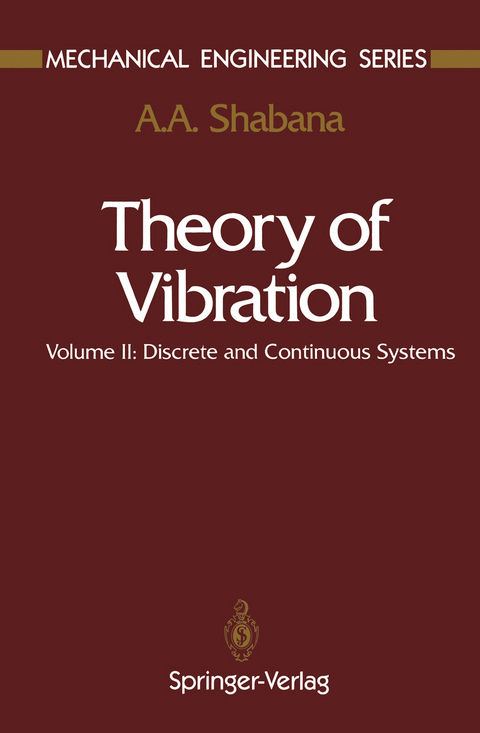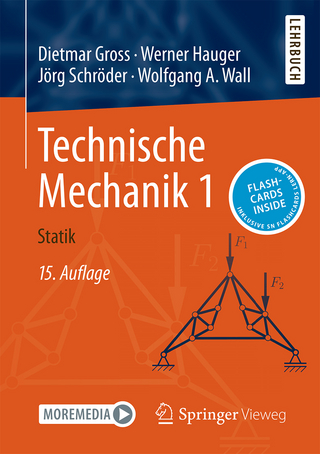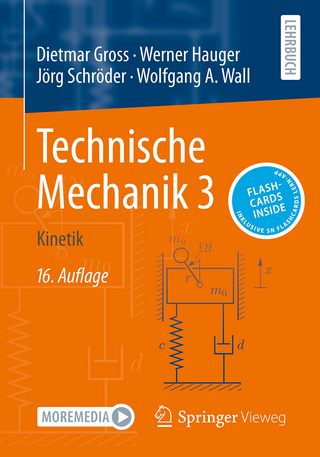
Theory of Vibration
Springer-Verlag New York Inc.
978-1-4684-0382-4 (ISBN)
The aim of this book is to impart a sound understanding, both physical and mathematical, of the fundamentals of the theory of vibration and its applications. It presents in a simple and systematic manner techniques that can be easily applied to the analysis of vibration of mechanical and structural systems. In this book, an attempt has been made to provide the rational development of the methods of vibration from their foundations and develop the techniques in clearly understandable stages. This is the first volume, entitled "An Introduction", intended for an introductory semester course in the theory of vibration. The solution procedures are explained in details easily understandable by students. The second volume, "Discrete and Continuous Systems", is planned for publication in the fall of 1990.
1 Introduction.- 1.1 Free Vibration.- 1.2 Logarithmic Decrement.- 1.3 Other Types of Damping.- 1.4 Forced Vibration.- 1.5 Impulse Response.- 1.6 Response to an Arbitrary Forcing Function.- References.- Problems.- 2 Lagrangian Dynamics.- 2.1 Generalized Coordinates.- 2.2 Virtual Work and Generalized Forces.- 2.3 Lagrange’s Equation.- 2.4 Kinetic Energy.- 2.5 Strain Energy.- 2.6 Hamilton’s Principle.- 2.7 Conservation Theorems.- 2.8 Concluding Remarks.- References.- Problems.- 3 Multi-Degree of Freedom Systems.- 3.1 Equations of Motion.- 3.2 Applications.- 3.3 Undamped Free Vibration.- 3.4 Orthogonality of the Mode Shapes.- 3.5 Rigid-Body Modes.- 3.6 Conservation of Energy.- 3.7 Forced Vibration of the Undamped Systems.- 3.8 Viscously Damped Systems.- 3.9 General Viscous Damping.- 3.10 Coordinate Reduction.- 3.11 Matrix-Iteration Methods.- 3.12 Method of Transfer Matrices.- 3.13 Concluding Remarks.- References.- Problems.- 4 Vibration of Continuous Systems.- 4.1 Free Longitudinal Vibrations.- 4.2 Free Torsional Vibrations.- 4.3 Free Transverse Vibrations of Beams.- 4.4 Orthogonality of the Eigenfunctions.- 4.5 Forced Longitudinal and Torsional Vibrations.- 4.6 Forced Transverse Vibrations of Beams.- 4.7 Inhomogeneous Boundary Conditions.- 4.8 Viscoelastic Materials.- 4.9 Application of Lagrange’s Equation.- 4.10 Rayleigh’s Method.- 4.11 Rayleigh-Ritz Method.- 4.12 Galerkin’s Method.- 4.13 Assumed-Modes Method.- References.- Problems.- 5 The Finite-Element Method.- 5.1 Assumed Displacement Field.- 5.2 Comments on the Element Shape Functions.- 5.3 Connectivity Between Elements.- 5.4 Formulation of the Mass Matrix.- 5.5 Formulation of the Stiffness Matrix.- 5.6 Equations of Motion.- 5.7 Convergence of the Finite-Element Solution.- 5.8 Higher-Order Elements.- 5.9 Spatial Elements.- References.- Problems.- Appendix A Linear Algebra.- A.1 Matrices.- A.2 Matrix Operations.- A.3 Vectors.- A.4 Eigenvalue Problem.- References.- Problems.
| Reihe/Serie | Mechanical Engineering Series |
|---|---|
| Zusatzinfo | XIII, 336 p. |
| Verlagsort | New York, NY |
| Sprache | englisch |
| Maße | 155 x 235 mm |
| Themenwelt | Kunst / Musik / Theater ► Design / Innenarchitektur / Mode |
| Naturwissenschaften ► Physik / Astronomie ► Mechanik | |
| Technik ► Bauwesen | |
| Technik ► Maschinenbau | |
| ISBN-10 | 1-4684-0382-6 / 1468403826 |
| ISBN-13 | 978-1-4684-0382-4 / 9781468403824 |
| Zustand | Neuware |
| Informationen gemäß Produktsicherheitsverordnung (GPSR) | |
| Haben Sie eine Frage zum Produkt? |
aus dem Bereich


